Introduction to the surface treatment process
The process method that uses modern physics, chemistry, metallurgy, heat treatment, and other disciplines to change the condition and properties of the surface of the part and optimally combine it with the core material to achieve predetermined performance requirements is called the surface treatment process.
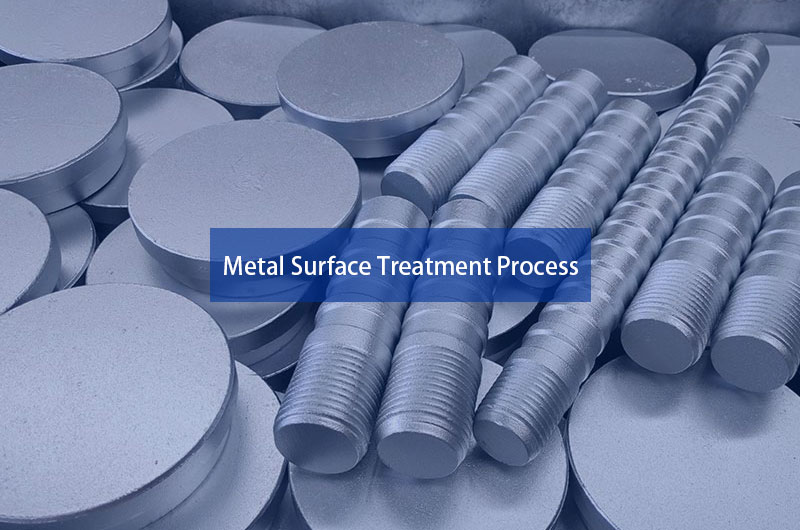
The role of surface treatment:
- Improve surface corrosion resistance and wear resistance, slow down, eliminate, and repair material surface changes and damage
- Make ordinary materials obtain surfaces with special functions
- Save energy, reduce costs, and improve the environment
Metal surface treatment process classification
It can be divided into 4 major categories in total: surface modification technology, surface alloying technology, surface conversion coating technology, and surface coating technology.
Surface modification technology: A surface treatment process that changes the morphology, phase composition, microstructure, defect state, and stress state of the material surface through physical, chemical, and other methods to obtain the required performance. The chemical composition of the material surface remains unchanged.
Surface alloying technology: A surface treatment process that uses physical methods to add materials into the matrix to form an alloyed layer to obtain the required performance.
Surface conversion film technology: A surface treatment process that uses chemical methods to chemically react between added materials and the matrix to form a conversion film to obtain the required performance.
Surface coating technology: A surface treatment process that uses physical and chemical methods to add materials to form a coating on the surface of the substrate to obtain the required performance.
Surface modification technology
Surface hardening
Surface quenching refers to a heat treatment method that uses rapid heating to austenitize the surface layer and then quenching it to strengthen the surface of the part without changing the chemical composition and core structure of the steel.
The main methods of surface quenching include flame quenching and induction heating. Commonly used heat sources include oxyacetylene or oxypropane.
Laser surface strengthening
Laser surface strengthening uses a focused laser beam to hit the surface of the workpiece to heat the extremely thin material on the surface of the workpiece to a temperature above the phase transition temperature or melting point in a very short time, and then cool it in a very short time to harden the surface of the workpiece. strengthen.
Laser surface strengthening can be divided into laser phase change strengthening treatment, laser surface alloying treatment, and laser cladding treatment.
Laser surface strengthening has a small heat-affected zone, and small deformation, and is easy to operate. It is mainly used for locally strengthened parts, such as blanking dies, crankshafts, cams, camshafts, spline shafts, precision instrument guide rails, high-speed steel cutting tools, gears, and internal combustion engines. Cylinder liner etc.
Sandblasting
What is sandblasting?
Sandblasting uses compressed air as power to form a high-speed jet beam to spray the spray material onto the surface of the workpiece to be treated at high speed so that the appearance or shape of the outer surface of the workpiece surface is changed to obtain a certain degree of cleanliness and different roughness—kind of craft.
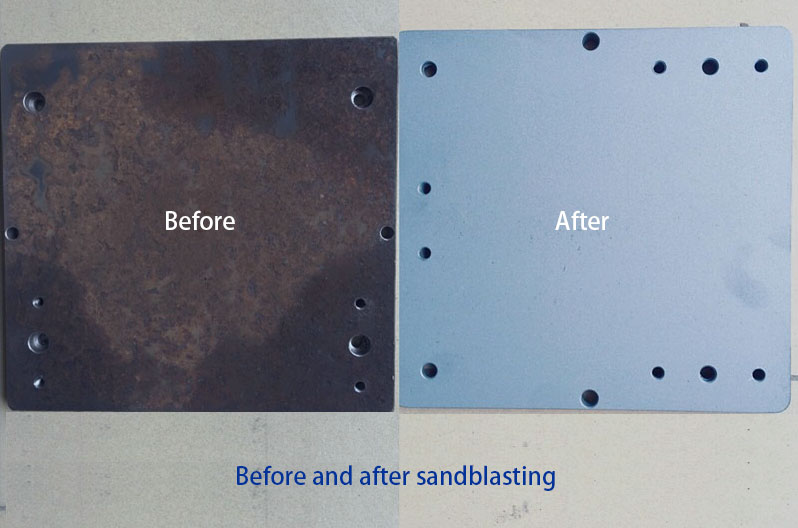
Technical features
- Achieve different reflective or matte colors
- It can clean the tiny burrs on the surface of the workpiece and make the surface of the workpiece smoother, eliminating the hazard of burrs and improving the grade of the workpiece
- Remove the residual dirt left during pre-treatment, improve the smoothness of the workpiece, and make the workpiece reveal a uniform metal color, making the workpiece more beautiful and beautiful in appearance
Shot peening
What is shot peening?
Shot peening is a technology that sprays a large number of high-speed moving projectiles onto the surface of a part to cause certain plastic deformation of the surface and subsurface layers of the part to achieve strengthening.
Effect
- Improve the mechanical strength of parts as well as wear resistance, fatigue resistance corrosion resistance, etc.
- Used for surface matting and scale removal
- Eliminate residual stress in castings, forgings, and weldments, etc.
Rolling
Rolling is the use of hard rollers or wheels to press the surface of the rotating workpiece at room temperature and move along the generatrix direction to plastically deform and harden the surface of the workpiece to obtain an accurate, smooth, and strengthened surface or surface treatment with a specific pattern. Craftsmanship. Mainly used in parts with relatively simple shapes such as cylindrical surfaces, conical surfaces, and flat surfaces.
Brushed
What is brushed?
Brushed is a surface treatment method that uses grinding products to form lines on the surface of the workpiece to achieve a decorative effect. According to the different textures after drawing, it can be divided into straight grain drawing, random grain drawing, corrugated grain, and spiral grain.
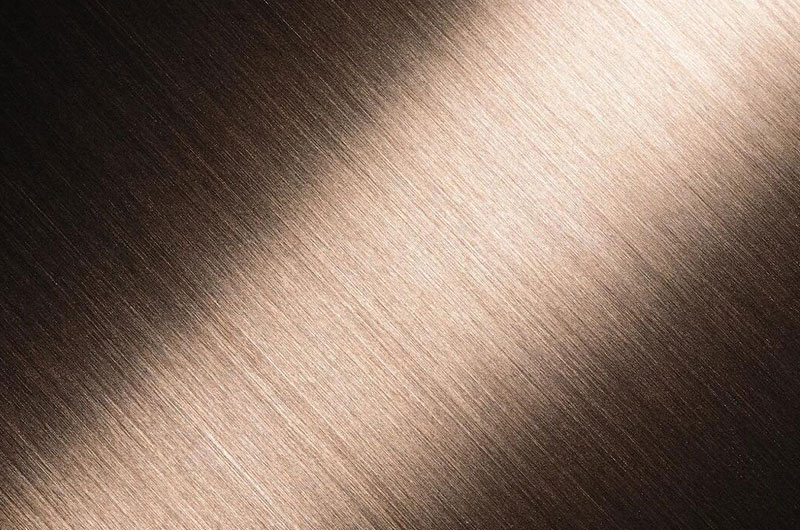
Technical features
Brushing treatment can give the metal surface a non-mirror-like metallic luster. At the same time, brushing treatment can also eliminate subtle defects on the metal surface.
Polishing
What is polishing?
Polishing is the use of flexible polishing tools and abrasive particles or other polishing media to modify the surface of the workpiece. Polishing is a finishing method that modifies the surface of the part. Generally, only a smooth surface can be obtained, which cannot be improved or even maintained. The processing accuracy depends on the pre-processing conditions, and the Ra value after polishing can reach 1.6~0.008μm. Choosing a suitable polishing wheel can achieve the best polishing effect and improve polishing efficiency.
Polishing type
- Mechanical polishing
- Chemical polishing
polishing process
- Rough polishing (basic polishing process)
- Medium polishing (finishing process)
- Fine polishing (glazing process)
Process flow
- Partial grinding
- Overall grinding
- Coarse throwing
- Fine polishing
- Cleaning
- Inspection
Technical features
Improve the dimensional accuracy or geometric shape accuracy of the workpiece, obtain a smooth surface or mirror gloss, and also eliminate the gloss.
Surface alloying technology
The typical process of surface alloying technology is chemical surface heat treatment.
Chemical surface heat treatment is a heat treatment process that places the workpiece in a specific medium for heating and insulation, so that active atoms in the medium penetrate into the surface of the workpiece, thereby changing the chemical composition and structure of the surface of the workpiece, thereby changing its performance.
Compared with surface quenching, chemical surface heat treatment not only changes the surface structure of steel but also changes its chemical composition.
According to the different elements infiltrated, chemical heat treatment can be divided into:
- Carburizing
- Nitriding
- Multiple co-penetration
- Infiltrate other elements
The chemical heat treatment process includes three basic processes: decomposition, absorption, and diffusion.
The two main methods of chemical surface heat treatment are carburizing and nitriding.
| Compared | Carburization | Nitriding |
|---|---|---|
| Purpose | Improve the surface hardness, wear resistance and fatigue strength of the workpiece while maintaining good toughness of the core. | Improve the surface hardness, wear resistance and fatigue strength of the workpiece, and improve the corrosion resistance. |
| Materials | Low carbon steel containing 0.1~0.25%C. The higher the carbon content, the lower the core toughness. | It is medium carbon steel containing Cr, Mo, Al, Ti, and V. |
| Common methods | Gas carburizing method, solid carburizing method, vacuum carburizing method | Gas nitriding method, ion nitriding method |
| Temperature | 900~950℃ | 500~570℃ |
| Surface thickness | Generally 0.5~2mm | No more than 0.6~0.7mm |
| Use | It is widely used in mechanical parts such as aircraft, automobiles and tractors, such as gears, shafts, camshafts, etc. | Used for parts with high wear resistance and precision requirements and heat-resistant, wear-resistant and corrosion-resistant parts. Such as the small shaft of the instrument, the light load gear and the important crankshaft, etc. |
Surface conversion coating technology
Blackening and phosphating
Blackening: A process in which steel or steel parts are heated to an appropriate temperature in air, water vapor or chemicals to form a blue or black oxide film on the surface. Also becomes bluish.
Phosphating: A process in which the workpiece (steel, aluminum, or zinc) is immersed in a phosphating solution (a solution based on some acid phosphates) and deposited on the surface to form a water-insoluble crystalline phosphate conversion film, which is called For phosphating.
Anodizing
What is anodizing?
Mainly refers to the anodizing of aluminum and aluminum alloys. Anodizing is to immerse aluminum or aluminum alloy parts in an acidic electrolyte. It uses electrochemical principles to generate an Al2O3 (aluminum oxide) film on the surface of aluminum and aluminum alloys. This oxide film has special properties such as protection, decoration, insulation, and wear resistance.
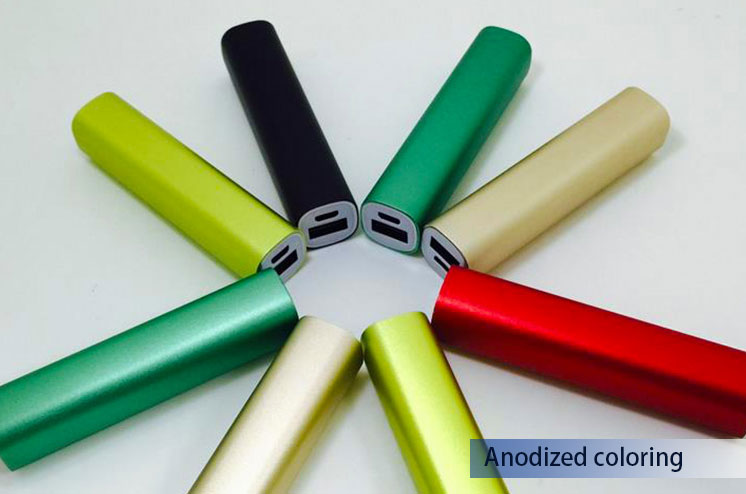
Before anodizing, it must undergo pre-processing such as polishing, degreasing, and cleaning, followed by rinsing, coloring, and sealing.
Production Process
General process:
- Degree
- Corrosion washing
- Neutralization
- Anodic oxidation
- Coloration
- Hole sealing
Single color, gradient color:
- Polishing/Sandblasting/Brushing
- Degreasing
- Anodizing
- Neutralize
- Dyeing
- Sealing
- Drying
Two colors:
Type 1:
- Polishing/Sandblasting/Brushing
- Degreasing
- Masking
- Anodizing 1
- Anodizing 2
- Sealing
- Drying
Type2:
- Polishing/Sandblasting/Brushing
- Degreasing
- Anodizing 1
- Laser engraving
- Anodizing 2
- Sealing
- Drying
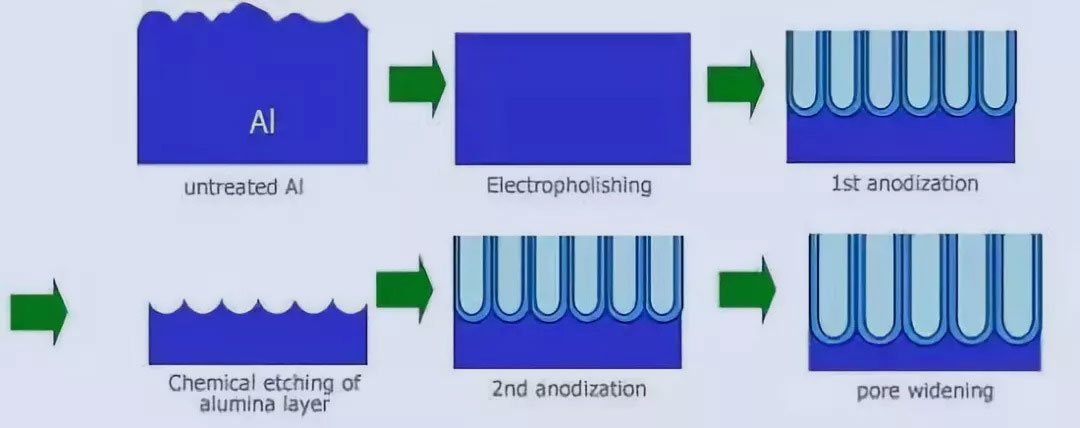
Technical features
- Increase strength
- Achieve any color except white
- Achieve nickel-free sealing to meet the nickel-free requirements of Europe, the United States and other countries
Application
It is often used for protective treatment of certain special parts of automobiles and aircraft, as well as decorative treatment of handicrafts and daily hardware products.
Summarize
The yield level of anodizing is related to the cost of the final product. The key to improving the oxidation yield lies in the appropriate dosage of oxidant, suitable temperature and current density. This requires structural parts manufacturers to continuously explore and seek breakthroughs during the production process.
Electrophoresis (ED-Electrophoresis deposition)
What is electrophoresis (ED-Electrophoresis deposition)
Electrophoresis is used for stainless steel, aluminum alloys, etc., which can make the product appear in various colors, maintain the metallic luster, and at the same time enhance the surface properties and have better anti-corrosion properties.
Process flow
- Pre-processing
- Electrophoresis
- Drying
Technical features
Advantage:
- Rich colors
- No metal texture, can be used with sandblasting, polishing, brushing, etc.
- Processing in a liquid environment can achieve surface treatment of complex structures
- The technology is mature and can be mass produced
Disadvantages: The ability to cover defects is average, and electrophoresis of die-casting parts requires high pre-processing requirements.
Micro-arc oxidation (MAO)
What is micro-arc oxidation?
Micro-arc oxidation is a process in which high voltage is applied to an electrolyte solution (usually a weakly alkaline solution) to generate a ceramic surface film. This process is the result of the synergistic effect of physical discharge and electrochemical oxidation.
Process flow
- Pre-processing
- Wash in hot water
- MAO
- Drying
Technical features
Advantage:
- Ceramic texture, dull appearance, no high-gloss products, delicate feel, and anti-fingerprint
- Wide range of base materials: Al, Ti, Zn, Zr, Mg, Nb, and their alloys, etc.
- The pre-treatment is simple, the product has excellent corrosion resistance, weather resistance, and good heat dissipation performance
Disadvantages:
At present, the colors are limited, and only black, gray and other mature colors are currently difficult to achieve. The cost is mainly affected by high power consumption, which is one of the highest costs in surface treatment.
Etching
What is etching?
Etching usually refers to etching, also known as photochemical etching. It refers to removing the protective film of the area to be etched through exposure plate making and development. During etching, it is exposed to chemical solutions to achieve the effect of dissolving corrosion and forming concave and convex or hollow molding effects.
Process flow
General process:
- Plain glass substrate
- Film formation
- Photoresist coating
- Exposure
- Development
- Etching
- Stripping
- Backplane output
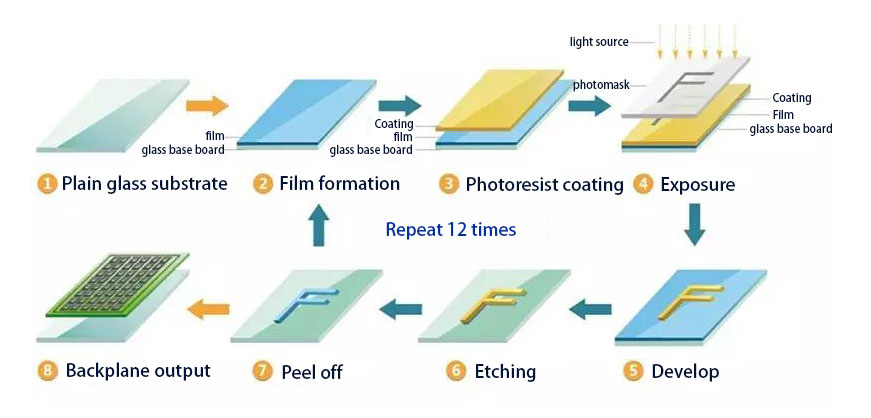
Exposure method:
The project will draw up the material preparation dimensions based on the drawings
- Material preparation
- Material cleaning
- Drying
- Filming or coating
- Drying
- Exposure
- Development
- Drying
- Etching
- Stripping
- Done
Screen printing method:
- Cutting materials
- Clean the plate (stainless steel and other metal materials)
- Silk screen printing
- Etching
- Stripping
- Done
Technical features
Advantage:
- Can carry out fine processing of metal surfaces;
- Give special effects to metal surfaces;
Disadvantages:Most of the corrosive liquids (acid, alkali, etc.) used in etching are harmful to the environment.
Surface coating technology
Thermal Spray
What is thermal spraying?
Thermal spraying is a method of heating and melting metal or non-metallic materials, and continuously blowing compressed gas onto the surface of the workpiece to form a coating that is firmly combined with the substrate, and obtains the required physical and chemical properties from the surface of the workpiece.
Thermal spraying technology can be used to improve the wear resistance, corrosion resistance, heat resistance and insulation of materials.
Application
Almost all fields including aerospace, atomic energy, electronics and other cutting-edge technologies.
Powder Coating
What is powder coating?
Powder spraying uses powder spraying equipment (electrostatic spraying machine) to spray powder coating onto the surface of the workpiece. Under the action of static electricity, the powder will be evenly adsorbed on the surface of the workpiece to form a powdery coating; the powdery coating is baked at high temperature Bake leveling and curing, resulting in a final coating with varying effects (different types of powder coating effects).
Process flow
- Preparation before spraying
- Electrostatic dust removal
- Spraying
- Low temperature leveling
- Baking
Technical features
Advantage:
- Rich colors, high gloss and matte optional
- Low cost, suitable for building furniture products and radiator shells, etc.
- High utilization rate, 100% utilization, environmentally friendly
- Strong ability to cover defects
- Can imitate wood grain effect
Disadvantages:Currently it is rarely used in electronic products.
Vacuum plating
Vacuum plating is a surface treatment process that deposits various metal and non-metal thin films on metal surfaces through distillation or sputtering under vacuum conditions.
Very thin surface coatings can be obtained through vacuum plating, which has the advantages of fast speed, good adhesion, and less pollutants.
According to different processes, vacuum plating can be divided into:
- Vacuum evaporation
- Vacuum sputtering plating
- Vacuum ion plating
Electroplating
What is electroplating?
Electroplating is an electrochemical and redox process. It is a process that uses electrolysis to attach a metal film to the surface of metal to prevent corrosion, improve wear resistance, conductivity, reflectivity and enhance aesthetics. kind of technology. Take nickel plating as an example: immerse a metal product in a solution of metal salt (NiSO4) as the cathode, and the metal nickel plate as the anode. After the DC power supply is turned on, a metal nickel plating layer will be deposited on the product.
Process flow
- Pre-processing
- Cyanide-free alkali copper
- Cyanide-free copper-nickel tin
- Chrome plating
Technical features
Advantage:
- The coating has high gloss and high-quality metal appearance
- The base material is SUS, Al, Zn, Mg, etc.; the cost is lower than PVD
Disadvantages:poor environmental protection and greater risk of environmental pollution
Electroplating method
- Ordinary electroplating
- Special plating
Vapor deposition
Vapor phase deposition technology refers to a new coating technology that deposits gas phase substances containing deposition elements on the surface of materials through physical or chemical methods to form a thin film.
According to the different principles of the deposition process, vapor deposition technology can be divided into two categories: physical vapor deposition (PVD) and chemical vapor deposition (CVD).
Physical Vapor Deposition (PVD)
What is Physical Vapor Deposition (PVD)
Physical vapor deposition is an industrial manufacturing process. It refers to the technology of using physical methods to vaporize materials into atoms, molecules or ionization under vacuum conditions, and deposit a thin film on the surface of the material through the gas phase process.
Physical deposition technology
- Vacuum evaporation
- Sputter plating,
- Ion plating
Schematic diagram of PVD principle
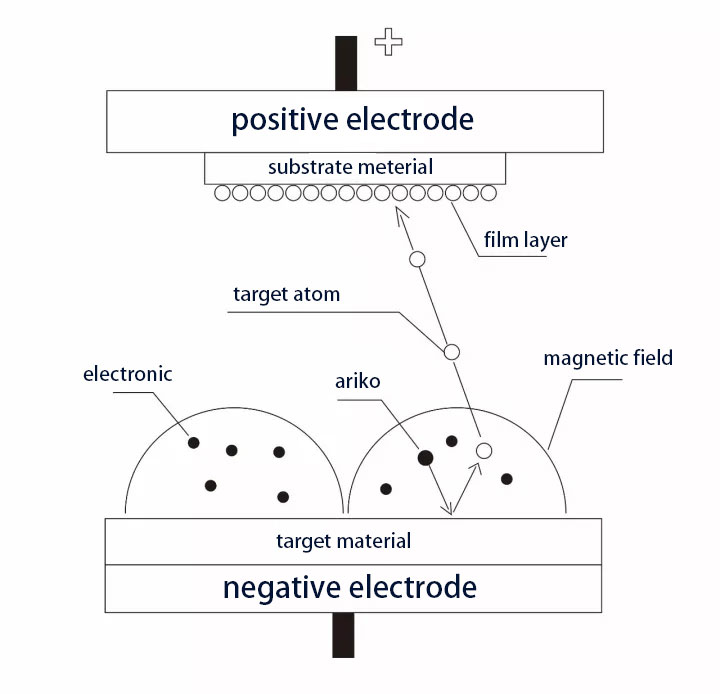
Process flow:
- Cleaning before PVD
- Vacuuming into the furnace
- Target washing and ion cleaning
- Coating
- After coating is completed, cool and come out of the oven
- Post-processing (polishing, AFP)
Technical features
PVD (Physical Vapor Deposition) can be used to coat metal surfaces with highly hard and wear-resistant cermet decorative coatings.
Application
It is widely used in the fields of machinery, aerospace, electronics, optics and light industry to prepare wear-resistant, corrosion-resistant, heat-resistant, conductive, insulating, optical, magnetic, piezoelectric, lubricating, superconducting and other thin films.
Summarize
Physical vapor deposition has the advantages of a wide range of applicable base materials and film materials; the process is simple, material-saving, and pollution-free; the film obtained has strong adhesion to the film base, uniform and dense film thickness, and few pinholes.
Chemical Vapor Deposition (CVD)
Chemical vapor deposition refers to a method in which a mixed gas interacts with the surface of a substrate at a certain temperature to form a thin film of metal or compound on the surface of the substrate.
Because the chemical vapor deposition film has good wear resistance, corrosion resistance, heat resistance and special electrical and optical properties, it has been widely used in industrial fields such as machinery manufacturing, aerospace, transportation, coal chemical industry, etc.
